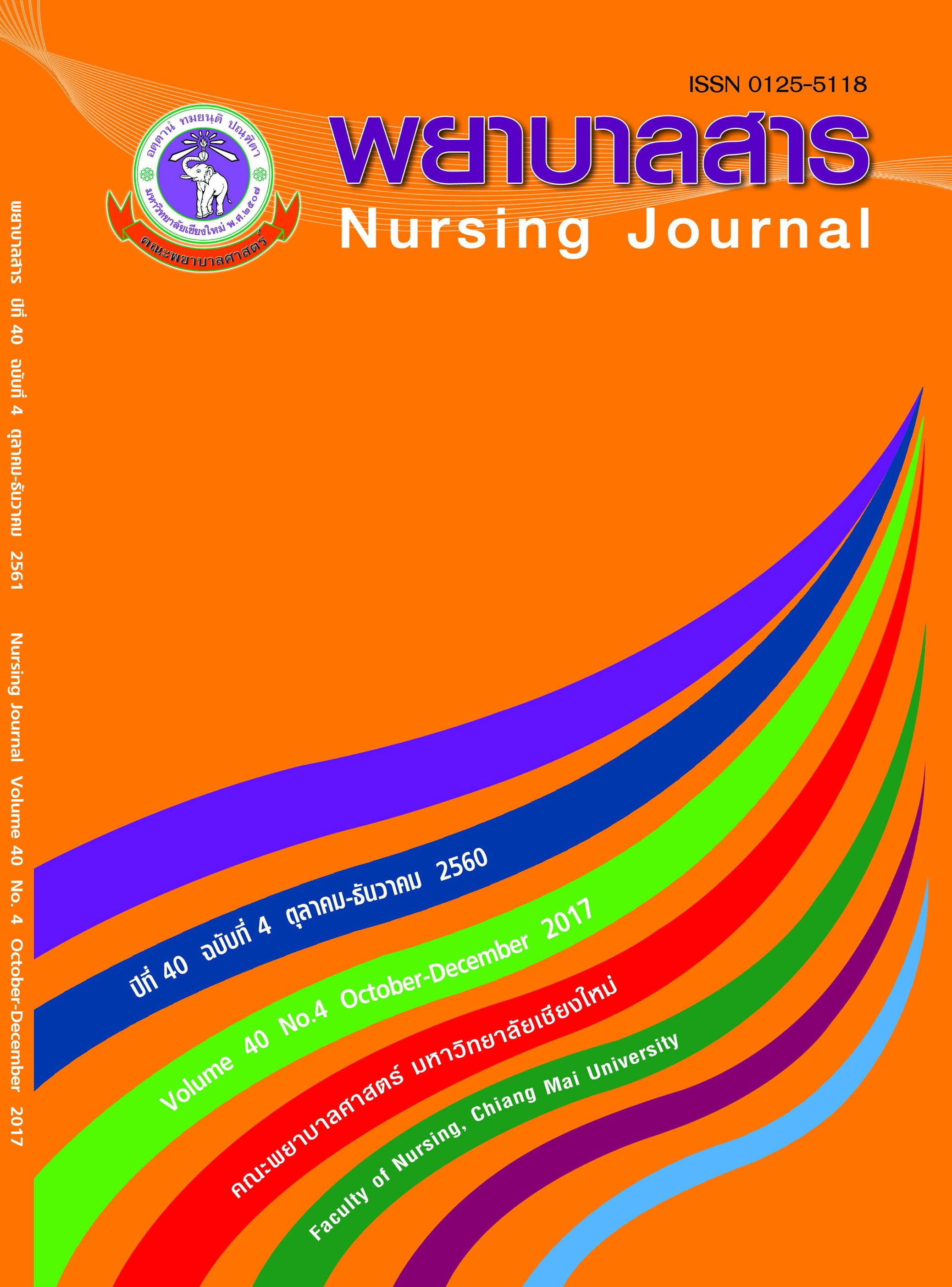Factors Predicting Seizure Prevention Practices in Children Among Caregivers
Keywords:
Caregivers of children with seizure, seizure prevention practices in children, predicting perceived Severity, , perceived barrier, perceived self-efficacyAbstract
Seizures in children impacts the health of both the child and their caregiver. Preventive actions by the caregiver could help children control their seizures. The purpose of this predictive correlational study was to explore and to predict the perceived severity of seizure, and the perceived barriers and self-efficacy of child seizure prevention practices among caregivers. The study sample, selected by purposive sampling, included 74 caregivers of children prone to seizures aged between 1 month and 6 years who attended Maharaj Nakorn Chiang Mai Hospital, Chiang Rai Prachanukroh Hospital, Lampang Hospital and Buddhachinaraj Hospital. The study instruments consisted of the Severity of Child’s Illness as Perceived by Parent Questionnaire, the Child Seizure Prevention Practices Among Caregivers Questionnaire, the Perceived Barriers Questionnaire and the Perceived Self-Efficacy Questionnaire. Data were analyzed by using descriptive statistics and stepwise multiple regression. The study results were as follows.
Caregivers had an overall high score for child seizure prevention practices. The mean score was 87.26. The score for fever management, antiepileptic drugs use and follow up, and general care routine were at a high level, with the mean scores being 26.32, 22.70 and 11.56, respectively. The score for trigger factor avoidances was at a moderate level, showing a mean of 27.24.
The score for perceived barriers was at a low level, with a mean score of 80.35, and the standard deviation is 11.47. The score for perceived self-efficacy was at a high level, with a mean score of 107.24, and the standard deviation is 1.00, and the score for perceived severity was at a good level, with a mean score of 4.28, and the standard deviation is 14.33.
The predictors of child seizure prevention practices among caregivers were perceived barriers, and perceived severity which together explained 46 % of the seizure prevention practices (R2 = .460, p < .001).
The study results provide basic information for child seizure prevention practices. This information could be used as a guide to promote appropriate child seizure prevention practices among caregivers.
References
2. นำไปวางแผนทางการพยาบาลในด้านการปฏิบัติการพยาบาล โดยส่งเสริมการจัดการให้ผู้ดูแลมีการรับรู้อุปสรรคและการรับรู้ความรุนแรงของโรคในการปฏิบัติป้องกันอาการชักในเด็กของผู้ดูแล เพื่อให้ผู้ดูแลสามารถควบคุมและป้องกันการเกิดอาการชักในเด็กได้
ข้อเสนอแนะในการทำวิจัยครั้งต่อไป
1. ควรมีการศึกษาการศึกษาวิจัยเชิงทดลองโดยการใช้ตัวแปร การรับรู้อุปสรรคของการปฏิบัติพฤติกรรม และการรับรู้ความรุนแรงของโรค เพื่อศึกษาว่าว่าตัวแปรที่กล่าวข้างต้นจะสามารถทำให้การปฏิบัติการป้องกันอาการชักเพิ่มขึ้นหรือไม่
2. ควรศึกษาในลักษณะของโรงพยาบาลที่เป็นทุติยภูมิ หรือในโรงพยาบาลชุมชน เพื่อดูความแตกต่างของการปฏิบัติการป้องกันอาการชักในเด็กของผู้ดูแล
เอกสารอ้างอิง
ไกรวรร กาพันธ์, ศรีพรรณ กันธวัง และอุษณีย์ จินตะเวช. (2553). การมีส่วนร่วมของผู้ปกครองในการดูแลเด็กที่มีความเจ็บป่วยวิกฤต ในหอผู้ป่วยหนักกุมารเวชกรรม และปัจจัยที่เกี่ยวข้อง.พยาบาลสาร, 37(3), 62-75.
จริญญา โคตรชนะ. (2552). ผลของการให้กลุ่มสนับสนุนทางสังคมต่อศักยภาพการอบรมเลี้ยงดูเด็กวัยก่อนเรียน และความเครียดของย่ายายในอำเภอภูเวียง จ. เลย. วิทยานิพนธ์ปริญญาพยาบาลศาสตรมหาบัณฑิต สาขาวิชาการพยาบาลครอบครัว บัณฑิตวิทยาลัยมหาวิทยาลัยขอนแก่น.
ทัศนียา วังสะจันทานนท์ และอ้อมจิต ว่องวาณิช. (2555). ประสบการณ์ของมารดาและการจัดการภาวะไข้ในเด็กอายุต่ำกว่า 5 ปี. วารสารการพยาบาลและการดูแลสุขภาพ, 30(4), 117-123.
ลัดดา อิ่มทองใบ. (2543). ปัจจัยที่มีอิทธิพลต่อพฤติกรรมของมารดาในการดูแลและป้องกันการกลับเป็นซ้ำโรคหอบหืดของบุตรอายุ 1-5 ปี ที่เข้ารับการรักษาในโรงพยาบาลของรัฐในเขตกรุงเทพมหานครและปริมณฑล. ปริญญาวิทยาศาสตรมหาบัณฑิต, บัณฑิตวิทยาลัย มหาวิทยาลัยเกษตรศาสตร์.
สุธรรม นันทมงคลชัย. (2547). การอบรมเลี้ยงดูเด็กของครอบครัวไทย: ข้อมูลจากการวิจัยเชิงคุณภาพและเชิงปริมาณ. กรุงเทพฯ: สำนักงานกองทุนสนับสนุนการวิจัย.
อนันต์นิตย์ วิสุทธิพันธ์. (2554). ตำราโรคลมชักในเด็ก. กรุงเทพมหานคร. ภาควิชากุมารเวชศาสตร์ คณะแพทยศาสตร์มหาวิทยาลัยมหิดล. โฮลิสติก พับลิชชิ่ง.
Bandura , A. (1997). Self-efficacy : The exercise of control. New York : W.H. Free man and Company.
Becker, M.H. (1974). The health belief model and personal health behavior. New Jersey: Charles B. Slack , Inc.
Chung, B., Wat, L. C., & Wong, V. (2006). Febrile seizures in southern Chinese children: Incidence and recurrence. Pediatric Neurology, 34(2), 121-126.
DiIorio, C. et al. (2004). Project EASE : A study to test a psychosocial model of epilepsy medication management. Epilepsy & Behavior, 5, 926-936.
Glanz, K., Rimer, B. K., & Viswanath, K. (2008). Health behavior and health education: Theory, research, and practice: John Wiley & Sons.
Kerr, C., Nixon, A., & Angalakuditi, M. (2011). The impact of epilepsy on children and adult patients’ lives: Development of a conceptual model from qualitative literature. Seizure, 20(10), 764-774.
Lv, R., Wu, L., Jin, L., Lu, Q., Wang, M., Qu, Y., & Liu, H. (2009). Depression, anxiety and quality of life in parents of children with epilepsy. Acta Neurologica Scandinavica, 120(5), 335-341.
National Institute for Health and Care Excellence. (2013). Feverish Illness in Children: Assessment and Initial Management in Children Younger than 5 Years. Clinical guideline No. 160. NICE, London.
Piaget, J. (1973). The child and reality. New York: Grossman publishers.
Polit, D.F. (2010). Statistics and data analysis for nursing research. (2nd ed.). Boston: Pearson.
Rosado, D., Seidenberg, M., Hermann, B., & Jones, J. (2013). Parental Perception of Seizure Severity in New-Onset Childhood Epilepsy. Clinical Neuropsychology,1, 41-42.
Russ, S. A., Larson, K., & Halfon, N. (2012). A national profile of childhood epilepsy and seizure disorder. Pediatrics, 129(2), 256-264.
Sajadi Hazaveh, M., & Shamsi, M. (2011). Assessment of mothers’ behavior in preventing febrile convulsion in their children in Arak City: An application of Health Belief Model. Journal of Jahrom University of Medical Sciences, 9(2), 34-41.
Wagner, J. L., Smith, G. M., Ferguson, P. L., & Wannamaker, B. B. (2009). Caregiver perceptions of seizure severity in pediatric epilepsy. Epilepsia, 50(9), 2102-2109.
Walsh, A., Edwards, H., & Fraser, J. (2007). Influences on parents’ fever management: Beliefs, experiences and information sources. Journal of Clinical Nursing, 16(12), 2331-2340
Downloads
Published
How to Cite
Issue
Section
License
บทความที่ได้รับการตีพิมพ์เป็นลิขสิทธิ์ของวารสารพยาบาลสาร
ข้อความที่ปรากฏในบทความแต่ละเรื่องในวารสารวิชาการเล่มนี้เป็นความคิดเห็นส่วนตัวของผู้เขียนแต่ละท่านไม่เกี่ยวข้องกับมหาวิทยาลัยเชียงใหม่ และคณาจารย์ท่านอื่นๆในมหาวิทยาลัยฯ แต่อย่างใด ความรับผิดชอบองค์ประกอบทั้งหมดของบทความแต่ละเรื่องเป็นของผู้เขียนแต่ละท่าน หากมีความผิดพลาดใด ๆ ผู้เขียนแต่ละท่านจะรับผิดชอบบทความของตนเองแต่ผู้เดียว






